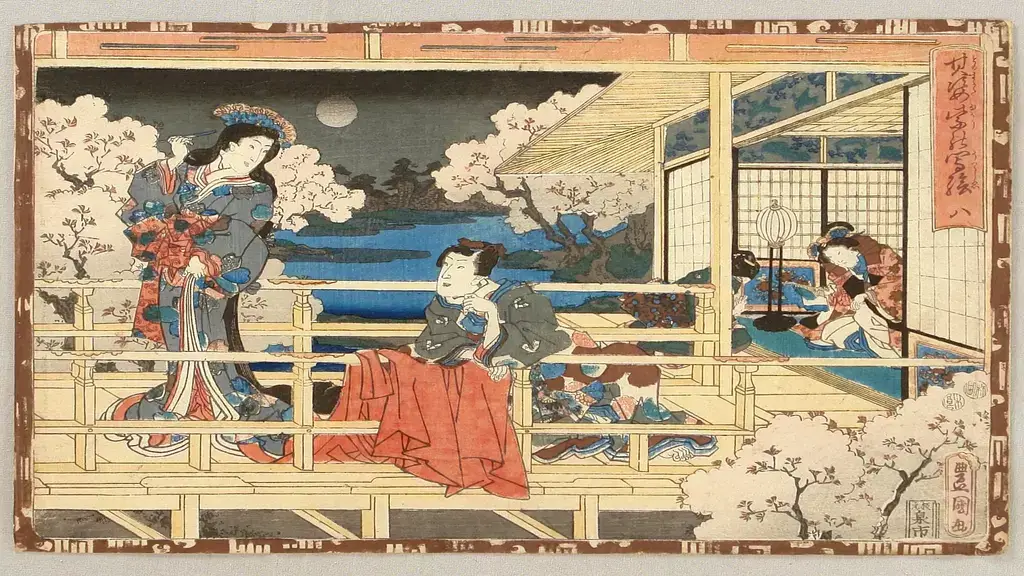the tale of genji
The Tale of Genji: One of the World’s Greatest Novels

Devon Lord-Moncrief
Posted on March 15, 2024
Share:

For thousands of years, many classic texts, books, and stories have helped shape world literature. While these stories have gained worldwide fame and recognition, The Tale of Genji, by Murasaki Shikibu, is one of Japan’s oldest stories, a work so celebrated that it has even been called Japan’s most remarkable novel.
Who was Murasaki Shikibu?
Born in 973 CE, Murasaki Shikibu was a woman of the Imperial Court during the Heian period (794-1185). Shikibu was born into power and privilege due to her family’s political standings before her birth. She lived a sheltered but ample life as a member of the aristocracy.

Much of her youth was spent living in her father’s residence, writing and learning classical Chinese, a rarity for a woman of her rank. Shikibu would later marry Fujiwara no Nobutaka and later still become a lady-in-waiting for Empress Shoshi. During these times, Shikibu wrote poetry and stories, the most famous being The Tale of Genji.
What is it about?
The Tale of Genji is a product of its time, both in style and substance. It tells a story of Imperial life, focusing on the titular character, Genji. Unlike other stories, The novel is unique because it doesn’t address its characters by their real names. Doing so in the Heian high court was considered rude, so characters are referred to by their stations or appearances.
It loosely follows the life of the court noble and some four hundred other characters. The events that unfold involve courtly intrigue, romance, and political drama. The story was meant to entertain 11th-century Heian courts so it can be challenging for modern readers, but current translations have fixed many of the text’s obstacles.
Are you looking for some fantastic snacks from across Japan? Sakuraco delivers traditional Japanese snacks, teas, and sweets from local Japanese makers directly to your door.
Who are some notable characters in The Tale of Genji?
Genji
The titular character of the novel. The son of Emperor Kiritsubo, Genji engages in constant love affairs and secret trysts. He is married yet seeks other women, even going so far as to fall in love with his stepmother. The novel follows Genji throughout his life, chronicling the drama and intrigue he sows.

Emperor Kiritsubo
Emperor Kiritsubo is the reigning emperor at the beginning of the story. He is Genji’s father, and he grants his son an unprecedented amount of power and influence throughout his life. Genji’s mother dies when he is three years old, which casts Emperor Kiritsubo into a depression. When he hears of a woman who resembles Genji’s mother, he chooses to marry her, setting the stage for further drama.
Murasaki no Ue
A ten-year-old girl who possesses outstanding beauty. Genji becomes so infatuated with her that he kidnaps her away from her village and takes her back home with him. Genji eventually falls in love with Murasaki when she grows older, and the two enter into a passionate, albeit controversial, relationship.

Why did it have such a significant impact on Japanese literature?
While there has been contention over the years about whether The Tale of Genji deserves its status as Japan’s first novel, many academics and scholars still credit it. It is not Japan’s first written work, but it is the first written work to constitute the definition of a novel. It has a progressive plot; its characters age in time with one another, events that affect the course of the plot, and it possesses psychological insight that differentiates it from other prose works.

Of course, many of these finer points are subjective in nature and have been and will continue to be argued over. Regardless, the novel remains a cultural and national classic in Japan, and its historical context is as educational as it is entertaining. Its legacy can still be seen today in countless adaptations in cinema, plays, novels, anime, and manga.
Why should I read The Tale of Genji?
The Tale of Genji is a classic, plain and simple. It is one of the world’s oldest stories and possibly the world’s first novel. It may be dense and challenging to follow for modern readers, but its legacy and historical importance cannot be overstated. Reading the story is like stepping into a time machine back to the days of Japanese antiquity.

It proves that even though over a thousand years have passed since its debut, people today are still incredibly similar to those of yesteryear. It is a seminal piece of world literature and an incredible Japanese culture that should not be overlooked. Have you ever read The Tale of Genji? Which version did you read? Did you enjoy it? Please let us know in the comments below! We would love to hear your thoughts on this timeless piece of Japanese literature.

Discover authentic flavors with Sakuraco
Get Sakuraco 

Discover authentic flavors with Sakuraco
Get Sakuraco 
Related Articles

Japanese Castles and More Wonderful Sights in Itabashi!
Japanese castles are reminders of Japan’s history and beautiful examples of the country’s architecture. Let’s check out Itabashi, which is home to some castle ruins.

Omikuji: The New Year’s Fortune
Omikuji, which means “sacred lot”, is a popular and traditional way to learn about your fortune in Japan. You can find it at Shinto shrines and Buddhist temples nationwide.

Ring in the New Year: The History of Joya no Kane
Joya no Kane is an important ritual during Japan’s annual Omisoka (New Year’s Eve) celebrations. Japan has practiced this ancient tradition for centuries, carrying a profound Buddhist philosophy.

Hokkaido Island: The Best Place for the Winter Holidays!
Hokkaido is the northernmost island of Japan and the most significant island after Honshu. It is surrounded by the Sea of Japan, Okhotsk, and the Pacific Ocean. It is particularly busy during winter. Being so far north and surrounded by water, snowfall is guaranteed yearly.



